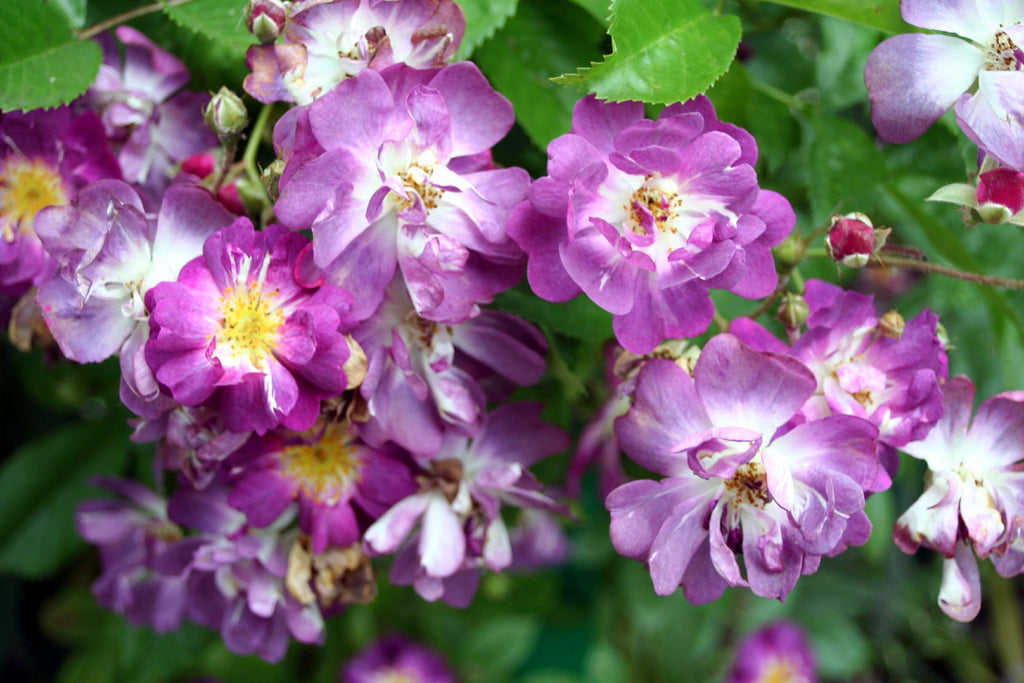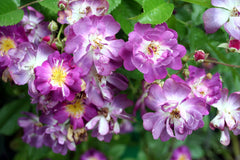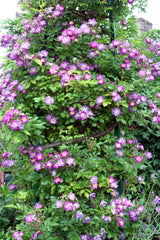



About this cultivar:
Rosa 'Veilchenblau' (Ra) is a mauve hybrid multiflora rose cultivar and the best known violet rambler. The name translates literally as ‘Violet’! Other names are 'Bleu-Violet', 'Blue Rambler', 'Blue Rosalie' and 'Violet Blue'.
Over 100 years old, it is an old rose that has stood the test of time! Bred by Hermann Kiese in Germany in 1909 its parents are the red hybrid multiflora 'Crimson Rambler' (Japan, before 1893) and the mauve hybrid setigera 'Souvenir de Brod' (Geschwind, 1884). It was introduced by Johann Christoph Schmidt from Erfurt, where Kiese had been employed until he started his own nursery in 1904. In 1993, 'Veilchenblau' was granted the Award of Garden Merit by the Royal Horticultural Society (what took them so long?).
The small, semi-double flowers have a sweet, fruity fragrance reminiscent of lily-of-the-valley. In autumn it develops small brown-red hips decorating the shrub into the winter. A robust, near-thornless rambler, this is usually trained as a climber. You can’t really go wrong with this classic rose!
- Position: Full sun, partial shade
- Soil: Almost any soil
- Flowers: June, July, August, September
- Other features: Scented, Royal Horticultural Society Award of Garden Merit (RHS AGM)
- Hardiness: Fully hardy, H7 - Hardy in the severest European continental climates (< -20°C)
- Habit: Climbing
- Foliage: Deciduous
- Height: 60 - 500 cm (1 - 16 ft) prune to your liking
- Spread: 60 - 500 cm (1 - 16 ft) prune to your liking
- Time to full growth: 5 to 10 years
- Plant type: Shrub, rose, climber
- Colour: Green, purple, white
- Goes well with: Aster, Geranium
About this genus:
Rosa is a woody perennial within the Rose family (Rosaceae). What is there to say? There are over 100 species and thousands of cultivars. They form a group of plants that can be erect shrubs, climbing or trailing with stems that are often armed with sharp prickles. Flowers vary in size and shape and are usually large and showy, in colours ranging from white through yellows and reds. Most species are native to Asia, with smaller numbers native to Europe, North America, and northwest Africa.
The name rose comes from French, itself from Latin rosa, which was perhaps borrowed from the Greek ródon. The ancient Greeks and Romans identified the rose with the goddess of love, Aphrodite (Greek name) and Venus (Roman name). In Rome a wild rose would be placed on the door of a room where secret or confidential matters were discussed. The phrase sub rosa, or "under the rose", means to keep a secret — derived from this ancient Roman practice.
The aggregate fruit of the rose is a berry-like structure called a rose hip. Rose hips are occasionally made into jam, jelly, marmalade, and soup or are brewed for tea, primarily for their high vitamin C content. They are also pressed and filtered to make rose hip syrup. Many Rosa cultivars do not produce hips, as the flowers are so tightly petalled that they do not provide access for pollination. Poor little bees. Rose perfumes are made from rose oil, which is a mixture of volatile essential oils obtained by steam distilling the crushed petals of roses. About two thousand flowers are required to produce one gram of oil! Rose petals also have a variety of culinary uses; from teas to salads and scones to ice creams
Ornamental roses have been cultivated for millennia, with the earliest known cultivation known to date from at least 500 BC in Mediterranean countries, Persia, and China. In the early 19th century the Empress Josephine of France patronized the development of rose breeding at her gardens at Malmaison. As long ago as 1840 a collection numbering over one thousand different cultivars was recorded at Abney Park in England.
As you may have guessed it is hard to be general about growing Roses. However, rest assured that all the roses we sell have been trialled and grown in our own wet clay soil garden at Ballyrobert in either full-sun or part-shade. We've chosen the ones that do best with us. Hopefully that should give you a bit of confidence or guidance!
We normally tie ramblers up walls or fences instead of climbers since ramblers are often more floriferous.

